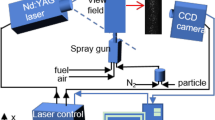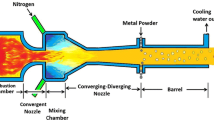Abstract
Independent control of high velocity oxygen fuel (HVOF) spray particle velocity and temperature has not been possible in the past, confusing the effect of either parameter on coating properties. This study describes a method by which velocity and temperature may be varied independently. Commercial HVOF equipment that was fitted with a special conical supersonic nozzle having four distinct particle injection locations was used. The present results, which were predicted in simulations and demonstrated in experiments, revealed several pertinent facts. First, particle velocity is principally related to combustion chamber pressure and is relatively unaffected by other design or operating conditions. Second, particle temperature is related to particle residence time within the nozzle, which can be controlled by the choice of particle injection location. In these experiments, the impact velocity and temperature of stainless steel particles were controlled within the ranges 340 to 660 m/s and 1630 to 2160 K, respectively. This range of parameters produced significant variations in splat morphology, coating microstructure, and coating oxide content. Such particle control allows the effects of velocity and temperature on coating properties to be assessed and controlled independently. These results also have commercial application, potentially enabling the user to tailor particle impact velocity and temperature to achieve specific coating properties.
Similar content being viewed by others
References
J.M. Houben: “Future Developments in Thermal Spraying,” in 2nd National Thermal Spray Conference, ASM International, Materials Park, OH, 1984, pp. 1–19.
A.P. Alkhimov, V.F. Kosarev, and A.N. Papyrin: “A Method of ‘Cold’ Gas-Dynamic Deposition,” Sov. Phys. Dokl., 1990, 35(12), pp. 1047–49.
R.C. McCune, J.N. Hall, A.N. Papyrin, W.L. Riggs, and P.H. Zajchowski: “An Exploration of the Cold Gas-Dynamic Spray Method for Several Material Systems,” in Advances in Thermal Spray Science and Technology, C.C. Berndt and S. Sampath, ed., ASM International, Materials Park, OH, 1995, pp. 1–5.
R.C. Dykhuizen, M.F. Smith, D.L. Gilmore, R.A. Neiser, et al.: “Impact of High Velocity Cold-Spray Particles,” J. Thermal Spray Technol., 1999, 8(4), pp. 559–64.
D.L. Gilmore, R.C. Dykhuizen, R.A. Neiser, T.J. Roemer, et al.: “Particle Velocity and Deposition Efficiency in the Cold Spray Process,” J. Thermal Spray Technol., 1999, 8(4), pp. 576–82.
P. Fauchais: “Formation of Plasma Sprayed Coatings,” J. Thermal Spray Technol., 1995, 4(1), pp. 3–6.
L. Bianchi, F. Blein, P. Lucchese, M. Vardelle, et al.: “Effect of Particle Velocity and Substrate Temperature on Alumina and Zirconia Splat Formation,” in Thermal Spray Industrial Applications, C.C. Berndt and S. Sampath, ed., ASM International, Materials Park, OH, 1994, pp. 569–74.
C.M. Hackett, G.S. Settles, and J.D. Miller: “On The Gas Dynamics of HVOF Thermal Sprays,” J. Thermal Spray Technol., 1994, 3(3), pp. 299–304.
C.M. Hackett and G.S. Settles: “The Influence of Nozzle Design on HVOF Spray Particle Velocity and Temperature,” in Advances in Thermal Spray Science and Technology, C.C. Berndt and S. Sampath, ed., ASM International, Materials Park, OH, 1995.
C.M. Hackett: “The Gas Dynamics of High-Velocity Oxy-Fuel Thermal Sprays,” Ph.D. Thesis, Penn State University, 1996. UMI order number 9628094.
R.C. Dykhuizen and M.F. Smith: “Gas Dynamic Principles of Cold Spray,” J. Thermal Spray Technol., 1998, 7(2), pp. 205–12.
H. Voggenreiter, H. Huber, S. Beyer, and H.-J. Spies: “Influence of Particle Velocity and Molten Phase on the Chemical and Mechanical Properties of HVOF-Sprayed Structural Coatings of Alloy 316L,” in Advances in Thermal Spray Science and Technology, C.C. Berndt and S. Sampath, ed., ASM International, Materials Park, OH, 1995, pp. 303–08.
R.J. Adrian: “Particle-Imaging Techniques for Experimental Fluid Mechanics,” Annu. Rev. Fluid Mech., 1991, 23, pp. 261–304.
M. Gharib and C. Willert: “Particle Tracing: Revisited,” Lecture Notes in Engineering, Advances in Fluid Mechanics Measurements, M. Gadel-Hak, ed., Berlin, Springer, 1989, 45, pp. 109–26.
H.W. Coleman and W.G. Steele: Experimentation and Uncertainty Analysis for Engineers, John Wiley-Interscience, New York, 1989.
J.R. Fincke, C.L. Jeffrey, and S.B. Englert: “In-Flight Measurement of Particle Size and Temperature,” J. Phys. E: Sci. Instrum., 1988, 21, pp. 367–70.
J.R. Fincke, W.D. Swank, and C.L. Jeffrey: “Simultaneous Measurement of Particle Size, Velocity, and Temperature in Thermal Plasmas,” IEEE Trans. Plasma Sci., 1990, 18(6), pp. 948–57.
J. Mishin, M. Vardelle, J. Lesinski, and P. Fauchais: “Two-Colour Pyrometer for the Statistical Measurement of the Surface Temperature of Particles Under Thermal Plasma Conditions,” J. Phys. E: Sci. Instrum., 1987, 20, pp. 630–35.
S. Kuroda: “Fundamental Phenomena in Spray Deposition of Surface Coatings,” in NRIM Research Activities, National Research Institute for Metals Japan, Tokyo, 1992, pp. 9–10.
D.P. DeWitt, and G.D. Nutter: Theory and Practice of Radiation Thermometry, John Wiley-Interscience, New York, 1988.
E.E. Underwood: Quantitative Stereology, Addison Wesley, Reading, MA, 1970.
G.S. Settles, and S. Garg: “A Scientific View of the Productivity of Abrasive Blasting Nozzles,” Proc. Steel Structures Painting Council 1994 Int. Conf., 12–19, 1994.
S.S. Garg, C.M. Hackett, J.W. Naughton, and L.N. Cattafesta: “A Comparison of Drag Laws for Predicting Particle Trajectory in High-Speed Flows,” 1996 ASME Fluids Engineering Summer Meeting, San Diego, CA, July 7–11, 1996.
J.W. Naughton: “The Enhancement of Compressible Turbulent Mixing Via Streamwise Vorticity,” Ph.D. Thesis, Penn State University, 1993.
P.A. Kessel: “A Study of the Aerodynamic Design of Viscous Nozzles Used to Accelerate Large Particles to High Velocity,” Ph.D. Thesis, University of Tennessee, 1977. UMI order number 7716589.
A.J. Sturgeon and D.C. Buxton: “The Electrochemical Corrosion Behavior of HVOF Sprayed Coatings,” in Thermal Spray Surface Engineering via Applied Research, C.C. Berndt, ed., ASM International, Materials Park, OH, 2000, pp. 1011–15.
E. Jussim and G. Kayafas: Stopping Time: The Photographs of Harold Edgerton, H.N. Abrams, Inc., New York, 1987.
Author information
Authors and Affiliations
Rights and permissions
About this article
Cite this article
Hanson, T.C., Hackett, C.M. & Settles, G.S. Independent control of HVOF particle velocity and temperature. J Therm Spray Tech 11, 75–85 (2002). https://doi.org/10.1361/105996302770349005
Received:
Revised:
Issue Date:
DOI: https://doi.org/10.1361/105996302770349005




